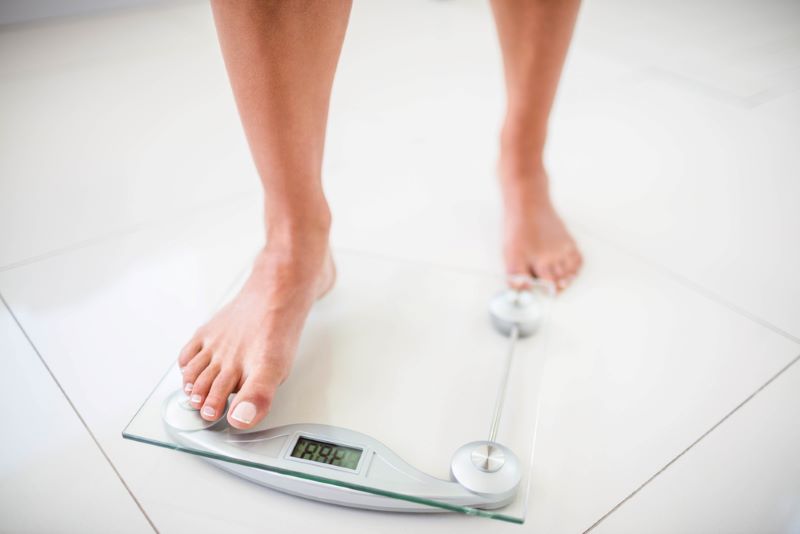Many people have a fitness goal of losing weight.
If this is you, you may be wondering how many reps of specific exercises (like push-ups) you need to do to lose a pound of body weight.
So, in this article, we look at answering the challenging question of how many push-ups you need to do in order to lose a pound.
While this might seem like a straightforward question, the answer is, unfortunately, a bit more complicated than you might think.

How Many Push-Ups Does It Take To Lose A Pound?
There’s no simple answer to this question. As everyone is different, there’s no one answer that will be correct for everyone.
As useful as it would be to give a single figure relating to the number of push-ups you need to do in to lose a pound, unfortunately, the science of weight loss complicates things and brings several factors into play that all need to be considered before we can answer this question.
We will cover these different factors and then tell you a rough number of push-ups the average man and woman have to do to lose a pound.
Your Bodyweight
The amount you already weigh will impact how many push-ups you’ll need to do to lose a pound.
In very basic terms, the more body weight you have, the more calories you will burn with each push-up as you’ll be working harder than someone with less body weight than you.
This might sound strange but when you consider that during regular push-ups, you’re lifting somewhere around 60% – 70% of your total body weight, it then makes sense that heavier people will be working harder as they’re actually lifting more weight than lighter people.
The more weight you have to move, the harder your working muscles will have to work, and the more calories you will burn with each push-up.
The more calories burned with each rep, the lower the number of push-ups you’ll need to do to lose a pound.
The Type of Push-Up

Something else to keep in mind is that different push-up variations will burn more calories than others.
For example, variations such as Mike Tyson push-ups, hindu push-ups, and clap push-ups will burn more calories than regular push-ups, diamond push-ups, and incline push-ups.
The main reason for this is that more muscle groups work to make the movement in some variations happen.
The more muscle groups that activate during your push-ups, the more calories you’ll burn and the fewer reps you’ll need to do to lose a pound.
If you only ever do one variation of push-ups, then it might be a sensible idea to think about changing if you can find one that better suits your goals of burning more calories.
How Many Calories You’re Consuming
No matter how much you understand the science behind how push-ups burn calories (which can lead to weight loss), unless you’re consuming fewer calories than you’re burning, you’ll find it almost impossible to lose weight regardless of how many push-ups you do.
One push-up will burn a set amount of calories.
To lose a pound, you’ll need to work out how many push-ups you’ll have to do to burn the right amount of calories.
However, if you’re consuming more than an average person of your height, age, and gender, then you’ll likely need to do more reps to hit your weight loss goals.
The Tempo Of Your Push-Ups
There are two ways of looking at this.
The first is that the slower you do your push-ups, the longer your muscles stay under tension which means they have to work harder for longer. This can result in a bigger calorie burn.
The other way to look at things though is that the faster you do your push-ups, the more of a cardiovascular exercise they become which could also lead to more calories being burned.
The tempo of your push-ups can have a big impact on the number of reps you’d need to do to burn a pound, so this isn’t something you should overlook.
Your Metabolic Rate
It’s also important to consider your metabolic rate. This is how many calories your body will burn at rest just to keep you alive and functioning.
If you have a higher metabolic rate than others, you might have to do fewer push-ups to lose a pound.
However, if your metabolic rate is lower than others, more push-ups will be needed to achieve your weight loss goal.
Everyone has a different metabolic rate and it’s affected by different things (including genetics).
If you’re struggling to lose weight despite doing lots of push-ups, working out your metabolic rate could be a good idea.
How Many Push-Ups Does It Take For The Average Male To Lose A Pound?

To lose a pound, you’ll need to burn 3500 calories.
Let’s say that an average male weighs around 200 pounds, consumes around 2500 calories each day, and does regular push-ups at a standard tempo.
If an average male did push-ups for 5 minutes (not necessarily back to back), he would burn 30 calories.
This works out at around 0.2 calories burned per push-up (if we say that it takes around 2 seconds to do each rep, therefore 30 push-ups are done per minute).
This means to burn the 3500 calories needed to lose a pound, he’ll have to do around 17,500 push-ups (3500 divided by 0.2).
How Many Push-Ups Does It Take For The Average Female To Lose A Pound?
Let’s say that an average female is 150 pounds, consumes around 2000 calories per day, and does regular push-ups at a standard tempo.
An average female would burn around 22 calories if they did push-ups for 5 minutes (again, if we say that it takes 2 seconds per rep so 30 push-ups are performed each minute).
This works out to around 0.15 calories being burned per push-up.
This means that the average female will need to do around 23,333 push-ups to burn the 3500 calories needed to lose a pound (3500 divided by 0.15).
Conclusion
In summary, there isn’t a one-size-fits-all answer to the number of push-ups it takes to burn a pound as there are a number of factors to consider.
That’s all for this article, but are diamond push ups dangerous? Or do push ups work legs?
Hope this helped!
Sources
Factors That Affect Weight Loss
I’ve been in the fitness and strength training industry for nearly a decade. In that time, I’ve gained 30 pounds of muscle, written hundreds of articles, and reviewed dozens of fitness supplements. As for my educational background, I’m a currently studying for my Active IQ Level 3 Diploma in Personal Training.

